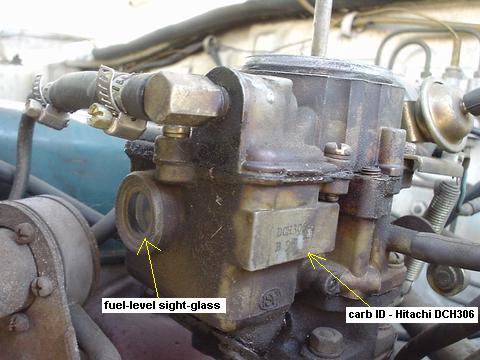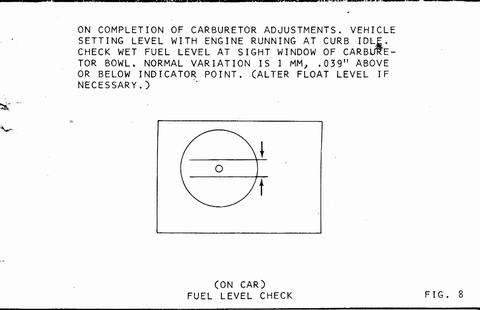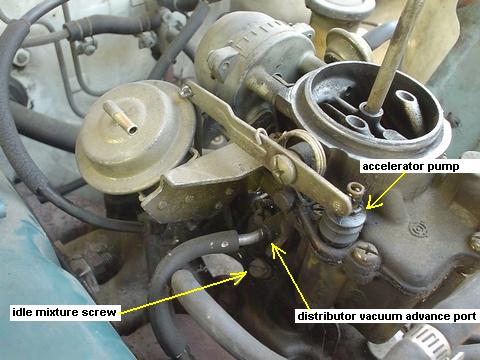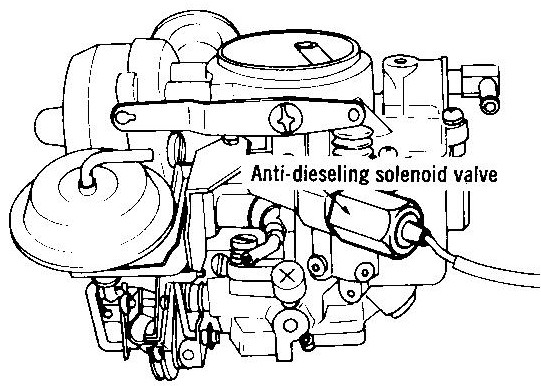This article is about the stock Hitachi carb, model Hitachi DCG-306 (manual choke) and DGH-306 (auto choke). However, much of the following generally applies to other standard venturi carbs like Weber carbs. But it doesn't discuss SU-type carbs like the Hitachi Sidedraft Carburetors used on the 1200 GX models.
Contents |
Overview
A prime focus of this article is: how to avoid buying parts you don't need. Instead, find the problem and fix it, or replace only what's actually bad. It's likely you can solve most problems without spending money replacing any parts. Rarely do cap, rotor, plugs, etc. need replacing, or even a new carb or rebuild kit be required. Even with used parts it should still run smooth. The points and condensor are the most likely to go bad, and a dwell meter will help tell the story there.
Where do I get a repair manual?
- eBay, usually for less that $10 USD. NOTE: Clymer, Chilton, etc general repair books include detailed carburetor info
- new, a Chilton manual is around $15 USD, try Amazon.com
- public library
- For a non-stock carburetor, there are books specifically for Weber, SU, etc carburetors
IMPORTANT: High fuel pump pressure can cause a high float, so perform the Fuel pump pressure test first -- before taking the carb apart to adjust the Float Level.
What to Check First - Float Level
Easy Tip! - check Float Level. An extra-nice feature of the Hitachi is the float glass sight-level. When running, look through the float glass and ensure the level of the fuel is right. It should be within 1 mm of the center line of the glass.
There is a dot in the center of the glass. With engine running, the fuel level should be very close to the centerline of the glass.
If it's higher or lower than 1mm from the dot, you need to adjust the float level as your first carb-adjustment step.
- If it's too high, the carb can flood and/or run rich
- If it's too low, it can run lean, hesitate (flat spot) or even run out of fuel on hard cornering!
- This can be adjusted independent of the other steps
Instructions for changing the float level are below in the Float Level section.
CAUTION: Float level is the foundation of the carburetor tuning. All other adjustments will be incorrect if the float level is incorrect. Check this first!
Engine Compression
If your engine has bad compression, you'll probably want to repair that first.
- If the compression is evenly low, you should be able to make your carb run better by continuing with the carb adjustment
- If only one or two cylinders have low compression, it won't help to adjust the carburetor. You must perform engine repair.
Step 1: Perform Engine compression test.
Each cylinder should be between 110-150 lbs pressure. Some variation is OK, but all cylinders should be within 25 lbs of each other. If one cylinder is 90 psi or below suspect bad rings or a burnt valve. In this case, adjusting the carb probably won't fix all the problems. Another rule of thumb, lowest cylinder pressure should be within 10% of highest cylinder pressure.
Engine Timing
Before touching the carburetor, make sure your engine Ignition Timing is right. This is the foundation of adjusting the carburetor. If this is off, adjusting the carburetor may not make the engine run any better. Also, timing problems might appear to be carb problems, so do this first to make sure.
Step 2: Perform Ignition Timing adjustment.
Check for Vacuum Leaks
Wait a minute! When do I get to adjust the carburetor?
Good question, but remember: Vacuum Leaks are your Worst Enemy -- they are a most common problem causing bad carburetor performance, if not the most common problem. So spend some important time on finding vacuum leaks.
See main article: Vacuum Leaks
Engine Off Inspection
Perform these steps before starting the engine.
Examine Hoses
Examine carefully all the vacuum hoses on the engine, especially the ends of each hose. Cut off cracked ends and refasten. This will fix or help prevent vacuum leaks at the hose ends.
Check the Play on the Throttle Shaft
With old carbs, this is also a critical wear spot. When buying a used carb, this is the most important thing to look for.
Wiggle the throttle shaft from side to side (90 degrees to the shaft). Wear is common with old carbs. It should feel tight with no discernible play. A worn shaft makes a vacuum leak: the engine idle rough, even to the point of killing the engine at stops and it can not be tuned to idle correctly.
- It should be tight, and if so no worries
- If it's loose, it needs to be drilled and bushings put in. See Carburetor Repair 2.
Visual Inspection
- Inspect all hoses for signs of cracking (especially at the ends of the hoses) or burning/melting. Replace any that are suspect.
- Check for free movement of the Heat Riser. If it is stuck, it can cause the engine to run poorly -- or even not at all! (depending at which position it is stuck)

- Ensure the secondary air flap moves freely. Move this lever up with your finger, and it should drop back down. If it moves stiffly or not at all, the carb will only work on its primary barrel!
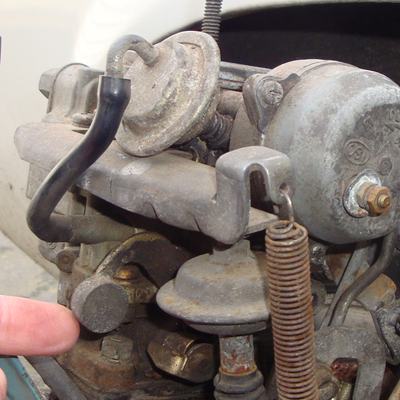
Accelerator Pump Test
Here's how the accelerator is supposed to work, whenever you open the throttle (depress the accelerator pedal):
- a little fuel is squirted direct into the carburetor throttle bores (running or not)
- if you do this too many times before starting the engine, you will "flood" the engine and it won't start until you let it sit for a while (give it time to let the fuel evaporate)
- if the accelerator pump (plunger) isn't working, the carb will idle, but not accelerate to a higher speed very well (if at all)
- if the accelerator pump is only partially working (only squirts a small stream), when accelerating the engine will 'hesitate', 'buck' or backfire
TIP: Old carbs from the 60s and 70s had leather pump gaskets, which dry up if fuel isn't kept in the carb. Sometimes when starting a carb that hasn't run in years, letting it sit a few days will let the seal expand, but other times it needs replacing.
Here's how inspect the accelerator pump:
- With engine off, take the air cleaner off
- Hold the choke open and look down into the carburetor
- Turn the throttle shaft or have someone "floor" the accelerator pedal
- You should see a definite smooth squirt of fuel from near the top of the throttle bore down into the bore
- If none is seen, or if it's intermittent, replace the accelerator pump inside the carb (see Internal Inspection section)
Slow Jets Loose?
There is also another slow on the opposite side. These must not be loose. Make sure they are finger-tight.
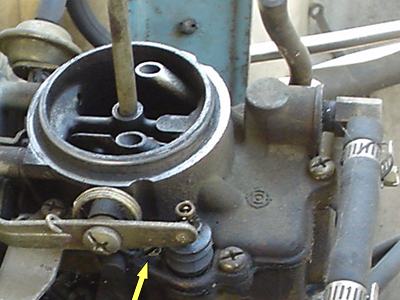
Vacuum Motor Testing - Engine Off
Here's your second chance to find those pesky vacuum leaks. Carb adjustments won't fix the problem until you perform this careful procedure.
Choke Test – Engine Cold
See main article Choke Operation and Adjustment
Engine Idling Tests
Start the engine and let it idle. We will now check for vacuum leaks. Only a few of the vacuum devices are actually powered at idle. The others only activate at certain temperatures or other conditions. So these are some you can test at idle.
Float Level Inspection
If the float level is incorrect, you will need to partially disassemble the carburetor. See Float Level Adjustment page.
Vacuum Testing - Choke Pull-Off
Temporarily disconnect and plug the hoses that go to the choke pull-off to see if it makes a difference. Just put a golf-tee or something to tightly plug the end of the hose. If the engine idles faster with host intact, but slower with the hose plugged, it indicates a leak).
choke and throttle vacuum motors

PCV Valve Test
Plug temporarily the hose going into the PCV valve (in the manifold, just under the carb) to see if the engine slows way down -- more than a little. This hose is difficult to get off, though if it isn't too stiff, you might be able to squeeze it shut with pliers. If it does lower the idle speed significantly, remove and clean (or replace) the PCV valve.
Leak Test - Gasket Junctions
If no leaks have shown up yet, spray the carb-manifold junction and the intake manifold-head junction with WD40 -- if is smooths out while spraying a particular spot, tighten the bolts or replace the gasket. The idea here is that the oil temporarily plugs the leak and you can hear the engine run differently.
CAUTION: Don't over-torque the bolts. That won't help, and potentially can break the bolt off.
LPG Vacuum Leak Test
Professional mechanics check for vacuum leaks by using a bit of LPG. (thanks to Matt)
- Find a small LPG (Liquified Petroleum Gas, I'm not sure what you'll have) cylinder from a camping stove and fit it with a flexible tube (5/16 fuel hose will do)
- Start the engine and get it idling, then drift a small amount of gas in the carb opening.
- If the engine running smoothes out with additional gas you have got an air leak.
- Now slowly drift gas around the manifold to head surface, carb to manifold, carb etc.
- If as you do this the engine smoothes out that area is where the leak is.
- If putting gas into the carb smoothed the running but no air leaks are found then it is probably a jetting or other carb set up problem.
Anti-dieseling solenoid valve
1973 and newer carbs may have an Anti-dieseling solenoid.
If this isn't working right:
- Engine won't idle, but drives good otherwise
This valve has one electric wire.
Make sure it's getting power when the ignition is on (engine running or not running, it should have power):
- Disconnect the wire connector
- Turn key to IGN (not Start)
- Listen carefully, while you connect wires together. You should hear a 'click' when connecting. Try it several times.
If no click is heard, replace the valve.
Choke Operation - Engine Warm
See the Choke Operation and Adjustment page.
Idle Speed and Mixture Adjustment
NOTE: Idle speed must be adjusted with engine fully warmed, choke butterfly fully open. Take off air cleaner lid and confirm the choke is fully open before proceeding.
- Adjust curb idle speed. Carburetor Specifications vary, but any stock A-series engine should idle fine at 750 rpm
- Mixture adjustment. Specs vary, but this will make any stock A-engine run nice:
- Adjust idle to 800 rpm
- turn mixture screw in (clockwise) to lean the mixture down to 750 rpm
- Just learning? To get a 'feel' for this adjustment, turn the screw by half turns clockwise and anticlockwise till you hear the engine speed up and slow down. Then fine turn with 1/4 turns. Do this repeatedly until you are confident of the results
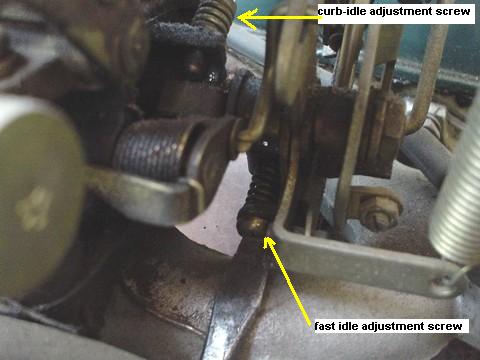
- Fast Idle: this is part of the choke adjustment, and isn't done with the engine warm. See the Choke section

![[Datsun 1200 encyclopedia]](/wiki/upload/wiki.png)
